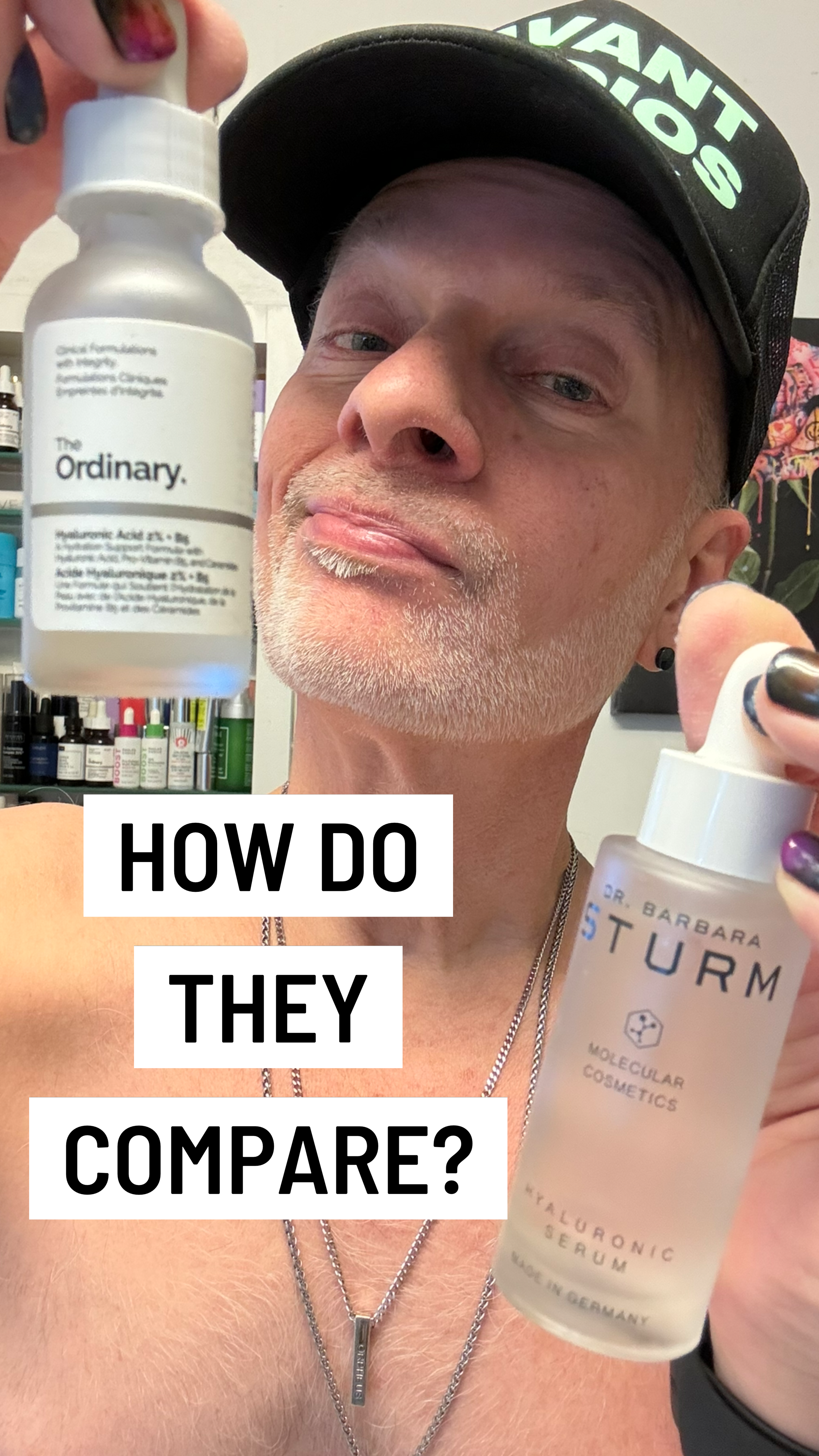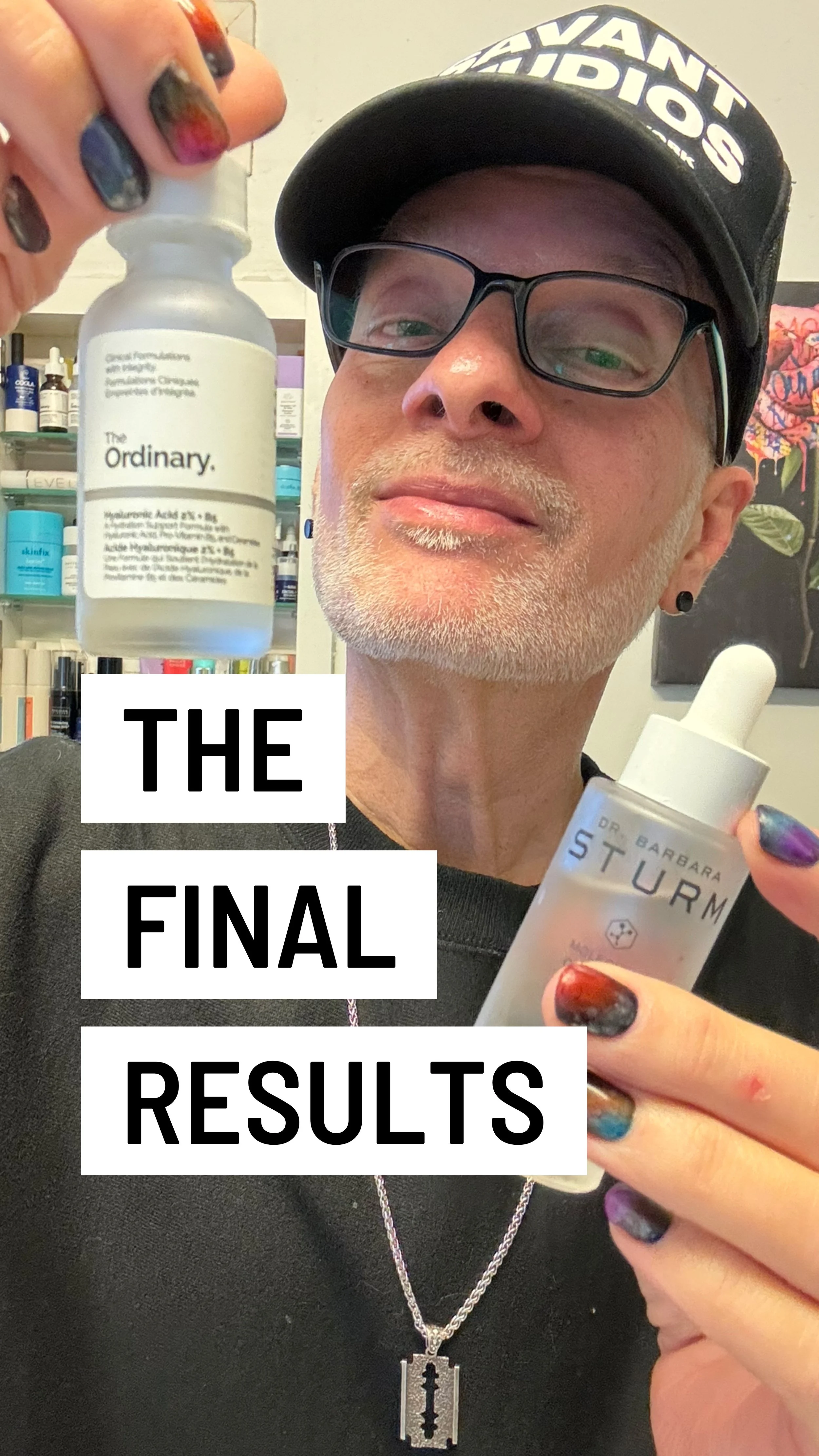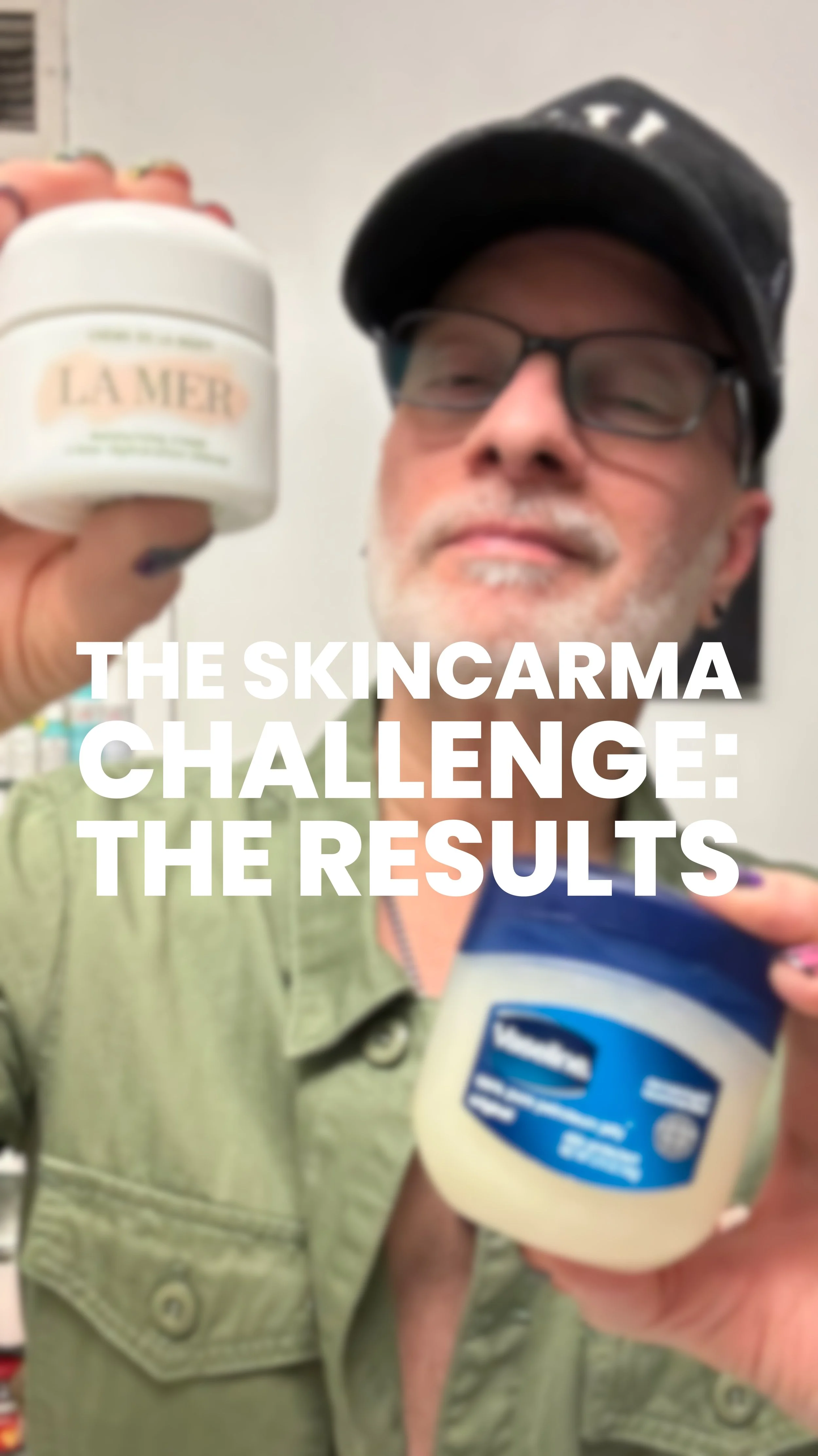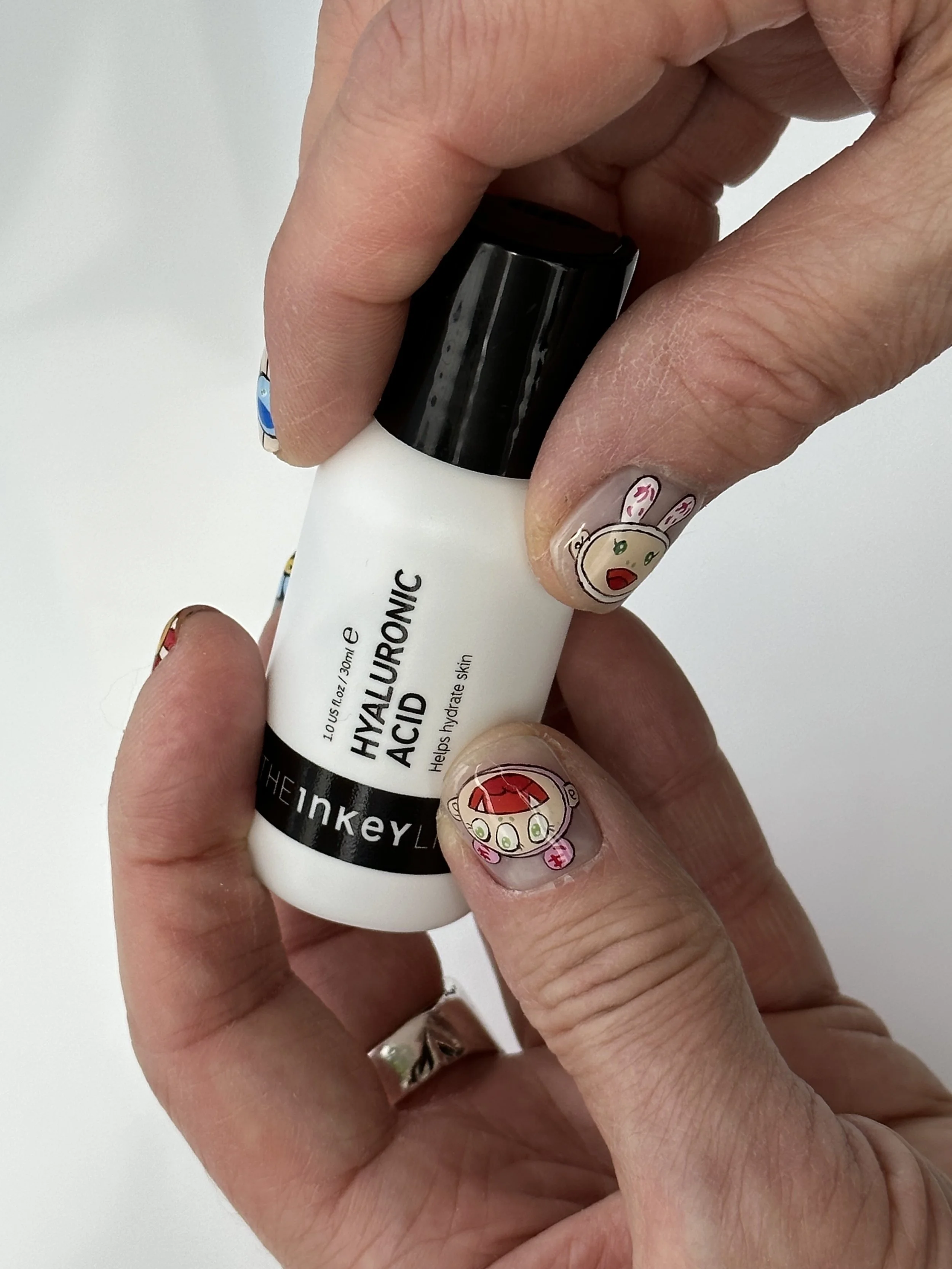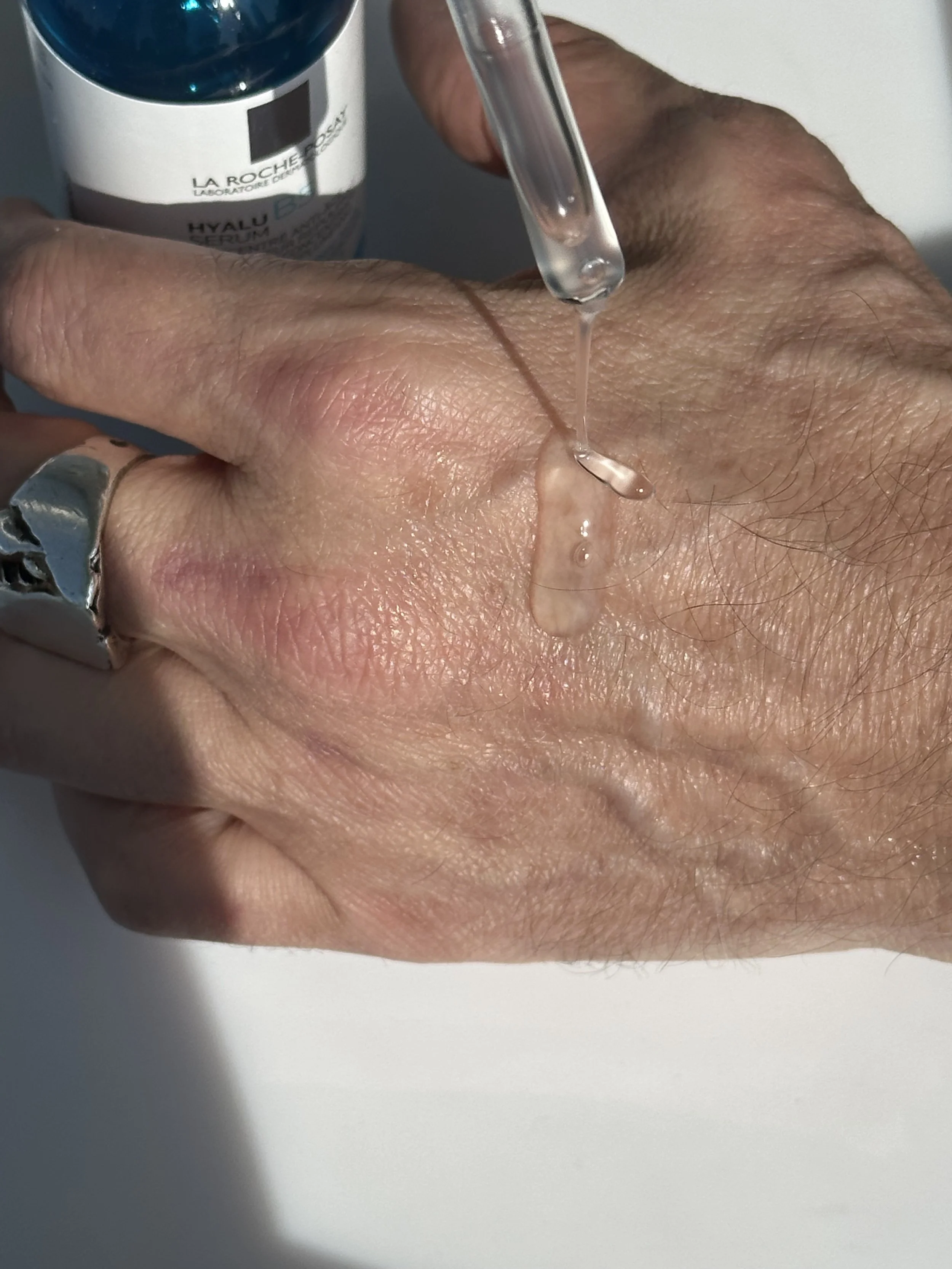PRODUCT REVIEW: THE ORDINARY HYALURONIC ACID 2% + B5 AND CERAMIDES - Is the hyaluronic acid good for sensitive skin? What's the difference between The Ordinary HA serums?
THE ORDINARY HYALURONIC ACID 2% + B5 AND CERAMIDES
Over the course of my three-decade beauty career, I have never been a fan (nor a friend!) of luxury skincare.
There’s simply very little authenticity in luxury beauty. I have rarely come across a luxury product that was legitimately worth the price. The efficacy never adds up. Quite simply, you never get what you pay for!
I’ve made no secret of the fact that there’s little difference between a $280.00 jar of Crème de la Mer and a $7 jar of Vaseline in promoting skin health. Both are good basic moisturizers – and not much more.
In fact, I directly compared the efficacy of the two classic skincare products in a Skincarma Challenge early last year. I have a few moisture reading tools in my drawer of devices under the bathroom sink. Over the course of seven days, I incorporated each moisturizer into my PM skincare routine, applying Crème de la Mer on the left side of my face, Vaseline on the right.
Each morning, before washing my face, I used my moisture meter to evaluate the levels of moisture and hydration on my forehead and checks – both left and right. After a week, it was clear that they were each effective at helping my skin retain moisture during the night. While the results weren’t overwhelming, the Vaseline did a slightly better job of maintaining my skin’s moisture levels. Yes, the $7 jar of Vaseline outperformed the $280 jar of La Mer.
BEST BEST PRODUCTS FROM THE ORDINARY
For my latest Skincarma Challenge, I wanted to test the efficacy of two more product icons – The Ordinary’s $10 Hyaluronic Acid 2% + B5 and the $325 Dr. Barbara Sturm Hyaluronic Serum. At one ounce each, these two popular face serums are the best-selling products in each brand’s product catalogue.
And they do the same thing. Exactly the same thing. They hydrate the skin.
Both Hyaluronic Acid hydrating serums are formulated with multiple HA molecules of varying molecular weights to presumably hydrate several skin layers deep. Large HA molecules don’t penetrate the skin barrier very well; smaller ones can go a bit deeper. It’s a delicate balance of science, chemistry and physics.
And each has additional actives that can also soothe irritation and smooth surface lines. (Like an inflated balloon, skin plumped up with hydration naturally appears smoother on the surface.) The biggest difference between the two HA serums? $315 – the gap between their retail prices.
Catch the results of my latest split-face comparison on my social channels. You can watch videos of my week-long journey – with early morning insights, measurements and musings on TikTok here and my Instagram page here.
THE SKINCARMA CHALLENGE: THE ORDINARY VS. BARBARA STURM
The Ordinary just reformulated their original HA serum. But before I get into my detailed product review of The Ordinary’s Hyaluronic Acid 2% + B5 just below, I wanted to explore some of the most frequently asked questions about Hyaluronic Acid and the difference between The Ordinary’s original and reformulated HA serums…
1. Is hyaluronic acid good for sensitive skin?
There’s often conflicting information about which ingredients are sensitizing for skin – and the actives to avoid if you have sensitive skin. I’ve read a lot about Hyaluronic Acid over the years, and I’m fairly certain, HA isn’t one of them.
In fact, Hyaluronic Acid possesses really good soothing benefits that help to calm irritation and even alleviate redness. The active is actually found in human skin and is classified as bio-compatible, making it among the best tolerated ingredients used in skincare.
According to Healthline, “As hyaluronic acid is a natural part of skin…allergic reactions to it are rare. Hyaluronic acid can work for people with any skin type — even those who have sensitive skin or are prone to breakouts.”
Despite that, you’ll still find conflicting information about it online, as in this article on the fashion magazine Glamour’s website titled, 9 Ingredients to Avoid If You Have Sensitive Skin. Sure enough, Hyaluronic Acid is on their list of no-no’s for sensitive skin.
Of course I trust no source more than the experts on the Paula’s Choice research team. “Those with dry or sensitive skin will experience the most improvement after incorporating hyaluronic acid into their routine, as the ingredient works to hydrate and boost skin’s barrier health.” Period.
Explore my picks of the best products from The Ordinary on the blog here.
Sources: Glamour: 9 Ingredients to Avoid If You Have Sensitive Skin; Healthline: How to Use Hyaluronic Acid the Right Way — and Why You Should; Paula’s Choice: Hyaluronic Acid for Skin - The Secret to Glowing Skin
2. Is it better to use hyaluronic acid or niacinamide?
While it’s common to compare popular skincare actives, Niacinamide and Hyaluronic Acid perform very different functions when it comes to skin health. Both ingredients are bio-compatible and found naturally in human skin.
Niacinamide, or Vitamin B3, is a potent antioxidant and one of the best anti-aging ingredients for preventing skin-aging environmental damage. Used consistently, Niacinamide can help to clear out pores, moderate surface oil, and brighten and unify your complexion. At high concentrations, it can also help to thicken the skin barrier to prevent moisture loss.
Hyaluronic Acid is most notable for its ability to lock onto water molecules in the skin and prevent trans-epidermal water loss, the fancy term for evaporation through the skin barrier. In addition, HA can help soothe irritation and reduce skin redness.
Explore my picks of the best products from The Ordinary on the blog here.
Sources: Paula’s Choice: Hyaluronic Acid for Skin - The Secret to Glowing Skin; NOTOXMD: Niacinamide Vs Hyaluronic Acid: Which One Is Better?
3. Is it OK to use hyaluronic acid every day?
Yes, you can use a Hyaluronic Acid serum daily – even twice a day. Despite the word ‘acid’ in its name, Hyaluronic Acid is not what’s termed a “direct acid” like Glycolic Acid. Direct acids possess exfoliating and resurfacing properties. Hyaluronic Acid, on the other hand, is a hydrating humectant that is naturally occurring in the skin.
When applied topically, Hyaluronic Acid is absorbed into the very top layers of the skin. Due to its large molecular weight, the molecule does not travel very deeply. In fact, many scientists argue that it doesn’t penetrate the skin barrier at all. It simply rests on top of the skin where it performs a similar function as naturally occurring HA found in skin cells: it draws water to the skin and holds it there.
It’s one of the best hydrators for skin and when used with an occlusive moisturizer, Hyaluronic Acid can be an essential component of a pro-skin health routine.
Explore my picks of the best products from The Ordinary on the blog here.
Sources: Cleveland Clinic: What does hyaluronic acid do for you?;
4. What's the difference between The Ordinary HA serums?
The Ordinary recently introduced an upgraded version of their classic Hyaluronic Acid 2% + B5 hydrating serum with additional molecular weight Hyaluronic Acid formats. While the original was always popular, it had one big drawback: a very sticky, icky texture. In fact, the product was so unpleasant to me, that it was never a part of my skincare routines and thus never appeared on the blog.
Rather than use the brand’s original HA serum, I long preferred The Ordinary’s
Marine Hyaluronics – a lighter, quickly absorbed hydrating serum with polysaccharides and algae extracts. Marine Hyaluronics is one of the very first skincare products I use each morning and I go through a bottle of it every 3 weeks.The Ordinary’s newly reformulated Hyaluronic Acid 2% + B5 is not as lightweight as Marine Hyaluronics but it’s much less tacky than the original. And, the brand added varied molecular weights of Hyaluronic Acid as well as ceramides for a more well-rounded, pro-skin health formula. Catch my full review of it just below.
Explore my picks of the best products from The Ordinary on the blog here.
Sources: Deciem Chat Room: The Ordinary Hyaluronic Acid & Ceramides – New Updated Formula
5. Product Review
The Ordinary Hyaluronic Acid 2% + B5 Review
I’ve made no secret of the fact that I was never a fan of the original version of The Ordinary’s Hyaluronic Acid 2% + B5. While it was a perfectly fine $10 hydrating serum with Hyaluronic Acid, it always felt like the cheapest skincare product in the brand’s product catalogue.
And it was.
There are multiple forms of Hyaluronic Acid in varying molecular weights used in skincare. For some reason, larger HA molecules are less expensive. And they’re also less pleasurable. They tend to make a serum sticky and thick. The experience is just gross.
And my guess is that The Ordinary’s marketers knew that – and its chemists likely had a solution to fix it. So they did. I’m excited to say that The Ordinary’s reformulated Hyaluronic Acid 2% + B5 is actually a pleasure to use!
And the new, lighter formula is a more effective hydrator than the sticky OG!
PRODUCT REVIEW: PAULA'S CHOICE CLINICAL 1% RETINOL TREATMENT
What makes The Ordinary Hyaluronic Acid 2% + B5 so much better than the original? Well, there are actually several reasons for its enhanced efficacy.
First and foremost, the reformulated serum contains five unique forms of Hyaluronic Acid at varying molecular weights for more extensive hydration throughout skin’s upper layers. This HA complex helps skin to more effectively hold onto moisture – the most important benefit of Hyaluronic Acid.
When assessing a product’s moisturizing efficacy, it’s important to look at how well it locks onto moisture in the skin and then prevents the escape of water through the skin barrier. I refer to this as “lock and block”.
Psst…I go into great detail of my “lock and block” philosophy in my videos comparing The Ordinary’s Hyaluronic Acid with Dr. Barbara Sturm’s Hyaluronic Serum.
It performs quite well at locking in hydration. But what about the “block” side of the equation? Well, in addition to those five forms of Hyaluronic Acid, The Ordinary added lipids, or oils, to the new Hyaluronic Acid 2% + B5 serum formula.
Lipids like ceramides and fatty acids are a key component of the skin barrier – the key component, in fact, that prevents moisture loss. And the newly reformulated HA serum now contains phospholipids and ceramides (in the form of sphingolipids) that perform that blocking function.
As the original, The Ordinary Hyaluronic Acid 2% + B5 is a relatively simple formulation, but a better hydrator than the brand’s original serum – and even a better hydrator than Barbara Sturm’s $325 Hyaluronic Serum.
With its enhanced efficacy and far better texture, it’s now a regular part of my daily skincare routine. And it’s still just $10.
6. Pros & Cons
What I like about it: The Ordinary Hyaluronic Acid 2% + B5 is a much better formula than the original. I love the improved texture and the addition of a broader range of HA molecules as well as lipids for a complete “lock and block” effect that keeps skin hydrated longer and more effectively.
What I don’t like about it: For $10, I like everything about it.
Who it’s for: All skin types, even sensitive skin and oily skin.
SHOP THE BLOG: Want to try it for yourself? Purchase the The Ordinary Hyaluronic Acid 2% + B5 for $9.90 here.
FIND OUT WHICH SERUM PERFORMED BETTER – AND BY HOW MUCH!
The Ingredient List of The Ordinary Hyaluronic Acid 2% + B5:
 sii|h 0 0, Pentylene Glycol solv|h, Propanediol solv|h, Sodium Hyaluronate Crosspolymer
sii|h 0 0, Pentylene Glycol solv|h, Propanediol solv|h, Sodium Hyaluronate Crosspolymer  sii|aox|h, Panthenol
sii|aox|h, Panthenol  so|h 0 0, Ahnfeltia Concinna Extract
so|h 0 0, Ahnfeltia Concinna Extract  vc, Glycerin
vc, Glycerin  sii|h 0 0, Trisodium Ethylenediamine Disuccinate chel, Citric Acid buff, Isoceteth-20 emu|surf, Ethoxydiglycol solv|h|perf 0 0, Ethylhexylglycerin pres, Hexylene Glycol solv|emu|perf|surf 0-1 0-2, 1,2-Hexanediol solv, Phenoxyethanol pres, Caprylyl Glycol h|emo
sii|h 0 0, Trisodium Ethylenediamine Disuccinate chel, Citric Acid buff, Isoceteth-20 emu|surf, Ethoxydiglycol solv|h|perf 0 0, Ethylhexylglycerin pres, Hexylene Glycol solv|emu|perf|surf 0-1 0-2, 1,2-Hexanediol solv, Phenoxyethanol pres, Caprylyl Glycol h|emoIS IT REALLY A SCAM?
Find out on my TikTok channel.
WATCH MY VIDEO REVIEW
THE BEST NIACINAMIDE SERUMS FOR CLOGGED PORES AND A BRIGHTER COMPLEXION
ON MY YOUTUBE CHANNEL HERE
WATCH MY VIDEO REVIEW OF
SKINCARE HACKS: GLYCOLIC ACID IS THE NATURAL DEODORANT THAT WORKS!
ON MY YOUTUBE CHANNEL HERE
WATCH MY VIDEO REVIEW OF
MY FAVORITE HUMECTANT SERUMS FROM PAULA'S CHOICE, THE INKEY LIST, GHOST DEMOCRACY AND MORE
ON MY YOUTUBE CHANNEL HERE
WATCH MY VIDEO REVIEW
COOL CLEAN FACIAL SUNSCREENS TO KEEP US SAFE AND SMILING IN THE SUN!
ON MY YOUTUBE CHANNEL HERE
WATCH MY VIDEO REVIEW
THE OPULUS BEAUTY LABS RETINOL SYSTEM – THE COOLEST RETINOL INNOVATION I’VE EVER SEEN
ON MY YOUTUBE CHANNEL HERE
WATCH MY VIDEO REVIEW OF
MY WINTER SKIN SAVIOR: SKINFIX BARRIER+ LIPID REPLENISHING SKINCARE
ON MY YOUTUBE CHANNEL HERE
WATCH MY VIDEO REVIEW
A COMPLETE K-BEAUTY ROUTINE WITH THE BEST FACIAL SKINCARE FROM PURITO, COSRX, MISSHA & MORE!
ON MY YOUTUBE CHANNEL HERE
WATCH MY VIDEO REVIEW
THE YEAR’S BEST VITAMIN C SERUMS WITH PAULA'S CHOICE, SUNDAY RILEY, THE INKEY LIST AND MORE!
ON MY YOUTUBE CHANNEL HERE
WATCH MY VIDEO REVIEW OF
A SELFCARE SUNDAY NOT FOR THE FAINT OF HEART – WITH THE PAULA’S CHOICE 25% AHA PEEL!
ON MY YOUTUBE CHANNEL HERE






